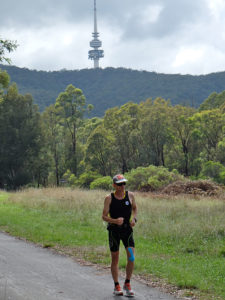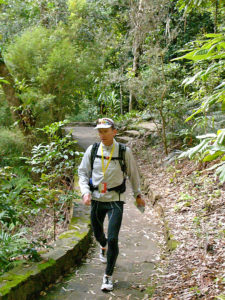 This article was written shortly before Martin completed his 5th Canberra Walking Festival event in 2016.
This article was written shortly before Martin completed his 5th Canberra Walking Festival event in 2016.
Dr.Martin Fryer is well known in the running community in Canberra, Australia and internationally, particularly in the ultramarathon arena. Martin has run over 100 ultramarathons since 1997 with highlights including wins at the Commonwealth 24 Hour Championships (UK, 2009: 255K), the Surgères 48 Hour Race (France, 2009, 433K), and the Sri Chinmoy 6 Day (2011: 784K) and 10 Day Races (2013: 1158K) in New York. In 2012 he set an age group (M50) World Record, running more than 247K on a 400m track in 24 hours in Taipei, Taiwan. More recently (June to August 2015), he finished in second place in the inaugural Tour de France footrace, in which he covered 2800K in 43 days without any rest days (equivalent to roughly 66 marathons).
Given Martin’s background, the organisers of the Canberra Walking Festival were a little surprised to see that Martin had entered their event for the first time in 2012 and has been participating every year since then. Naturally he entered the longest distances available each day, completing the marathon on the Saturday, followed by a 30km walk on Sunday. As might be expected, he has been the first to finish each year, although the event is not timed, and there are no prizes for coming first.
Martin is not the only runner who has walked in the Canberra Walking Festival, but we were interested to find out a little more about what attracted Martin to this event, and what keeps him coming back.
How did you first find out about the Canberra Walking Festival and why did you decide to participate?
I first found out about the Canberra Walking Festival in 2012 when I was doing an internet search for local road walking groups and/or events. The reason for that search was that I had incorporated walking into my ultramarathon training program since my first 24 Hour race in 2004 and was now looking for some social and structured way to continue that kind of training. When I saw that the Canberra Walking Festival had a full marathon walk on the Saturday followed by a 30K walk on the Sunday I knew that I had found a wonderful, challenging way of getting in two long back-to-back hard walks that would not only boost my walking strength and fitness but also give me a whole weekend of touring around Canberra’s superb paths and trails that I love so much.
How does a walking event of this nature compare to some of the other multi day running events you have completed?
The degree of challenge has been relatively high for me each year as I do the 42K/30K double without any prior long, hard, structured walking in preparation, so it is a matter of just winging it and using the event as a solid walk training block. The walking that I do in my normal training is usually in short bursts of 1 to 3 minutes interspersed between running periods that are roughly 3 to 5 times the walk duration. Quite a lot of this walking is also done on uneven trails rather than nice smooth bike paths, so the Canberra Walking Festival allows me to include some lovely long stretches of smooth surface in which I can get a good rhythm going. The overall difficulty is nothing like a multiday event where nutrition, hydration and trying to get sleep and recovery are major concerns. Therefore, my aim in the Canberra Two Day Walk is to push myself hard as I can. I do wake up very sore on the Sunday morning (following the previous day’s marathon) with tight hips and sore shins but normally these issues settle out after a bit of a warm up.
What sort of pace do you aim for when walking?
For the Canberra Two Day Walk I had no goal pace in the first year but now I roughly aim for somewhere between 8:00 and 8:30 min/K average pace for the marathon (5h45-6h) on the Saturday and a little faster on the Sunday.
What type of walking do you prefer?
I actually like a wide variety of locations, surfaces and terrains though if I was pushed I would say that my favourites involve long, steady climbs on non-technical bush tracks in the Brindabella Mountains and Namadgi National Park (ACT) that culminate in amazing views. I have no training in racewalking technique so I guess that I have some kind of fitness walking style?
 The rules of the Canberra Walking Festival specify “no running”. Do you find it difficult complying with this rule?
The rules of the Canberra Walking Festival specify “no running”. Do you find it difficult complying with this rule?
Not at all. The whole point of participating in these events for me is to walk and to strengthen some of those different muscle groups and tendons that are different to running, so I have no temptation at all to start running. In fact, in 2012 I followed up my Canberra Two Day Walks with a 24 Hour Walk at Coburg in April. Walking form is strictly observed at this event and I managed to cover 152 km in my first attempt, making me vow to go back one day and get the 100 miles with some proper training!
You also train other novice ultra runners and I recall you saying that you include walking as part of their training programs.
Walking is an absolutely critical part of the programs that I prepare for my ultramarathon squad, whether they are a novice or an experienced World class athlete. Most runners that I prescribe walking to know that it is in their best interests for high performance when I show them my results and other high performers in the squad (a few members of my squad were part of the Silver Medal Mens Team at the World 24H running Championships in 2015), but ultimately they quickly find out for themselves that it is not only a nice change, but they can cover long training distances with considerably less stress on the body.
The training sessions that I prescribe range from very long run/walks at a given time or distance ratio through to occasional pure power walks done for 45 to 90 min at maximum effort. There are so many advantages to being able to walk well for ultra-endurance athletes: it allows a change of muscle groups and a lowering of heart rate, it allows short breaks to take in food and drink without the bouncing of running, it is low impact, it works runners in a low aerobic fat burning zone, and it allows runners to do very long run/walks that allow faster recovery than pure runs and thus not interfere with the rest of the weekly program.
Why would you recommend the Canberra Walking Festival to other runners?
For all of the reasons described above: excellent low end aerobic training, superb courses and scenery, great organisation, meeting walkers from all around the world, very modest entry fees, great food from the local Scout groups at the end, and more than anything- getting out of your running comfort zone and doing something completely different! I should also point out that runners do not need to push themselves to complete the longest distances available on each of the two days. For example, a 5km parkrunner might choose to walk 10-11km on each day, and still find that to be an enjoyable but still challenging experience.
